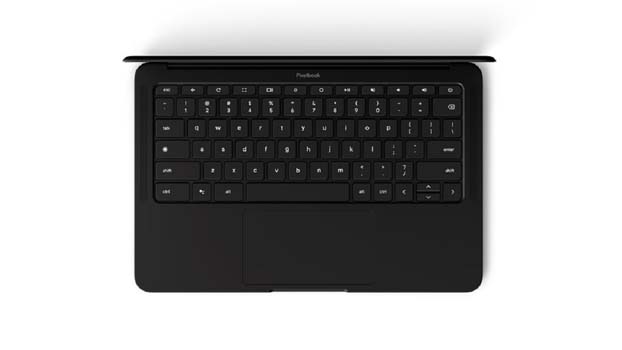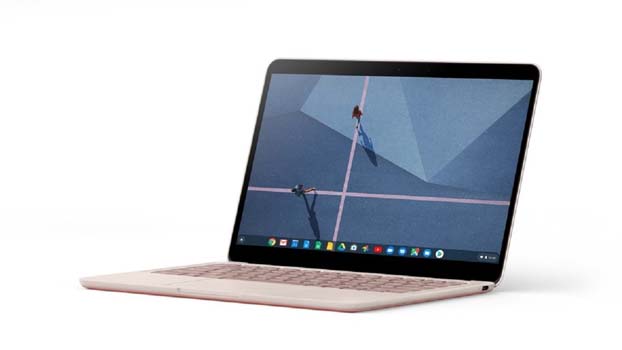The Google Pixelbook Go: The price of simplicity

The Pixelbook Go is a handsome 13.3-inch laptop with an understated, clean design. Or at least, the black model I am using is understated — it will also eventually be offered in a color Google calls “Not Pink,” that has a soft pink finish with a bright, coral base. It’s not hugely different looking from a MacBook Pro, if you could get one of those in black.
It weighs 2.3 pounds and feels sturdy and trustworthy thanks to a magnesium chassis. Many Chromebooks have plastic bodies, so part of what you’re paying for with the Pixelbook Go is the materials. Google has coated that magnesium with a soft paint that’s almost plastic-like. I can’t tell you if it will chip or scratch easily — it hasn’t during my week of testing, at least — but I suspect it’ll hold up fairly well.
The whole thing is gently curved around the edges, and if it weren’t so well-made I would say it’s prototype-y in the way Google hardware used to be. The most notable design element is the bottom, which is ridged for grip. The keyboard is backlit and flanked by two speakers that are respectable, if not impressive for a laptop of this size.
Google took the already excellent Pixelbook keyboard and iterated on it a bit, making the keys slightly quieter. I’ve tried keyboards that aim for silence in the past and they usually end up feeling mushy, but that’s not the case here at all. The keys have good travel and a good amount of springy resistance. If you like clacky mechanical keyboards, this isn’t for you.
The trackpad underneath the keyboard is large, but not massive. Google has done a good job with palm rejection on it, too. Unlike the Pixelbook, the trackpad on the Go doesn’t extend all the way to the bottom lip of the keyboard deck, so it’s less prone to mis-clicks.
Unfortunately, the Pixelbook Go doesn’t have any kind of biometric authentication like a fingerprint sensor or face unlock. Google points out that you can pair it with an Android phone and use that phone’s biometrics to unlock the laptop. Same applies for the lack of LTE options — it’s easy to tether to your Pixel phone directly from the system menu.
You can lift up the screen with just one finger, but you can’t flip it all the way around to put the laptop into tablet or tent mode. As bad as tablet mode on Chrome OS still is, I do wish it was still an option here, if only for setting it up in a tent mode to watch movies on a plane.

Three of the four Pixelbook Go models come with a 1920 x 1080, 16:9 LCD touchscreen. The bezels on the top and bottom of the screen are on the large side, but the screen itself gets plenty bright and doesn’t inspire any complaints. Really, my only problem is with that aspect ratio: I’m not a fan. I know not everybody likes the taller 3:2 aspect ratio on laptops, but even 16:10 would have felt a little less cramped when I’m browsing websites.
Pixelbook Go models are fanless because all of them use Intel Y-series chips. In fact, Google is using 8th Gen Intel chips instead of something newer. That’s partially a cost saving measure, I suppose, but the truth is I didn’t notice any real problems with speed. I’m testing the mid-range model with the Core i5 and 8GB of RAM and have yet to encounter any real slowdowns.
Battery life is also excellent. I haven’t quite reached Google’s claimed 12 hours of use, but I haven’t had any problems getting through a full eight-hour workday. The Pixelbook Go also supports fast charging over either USB-C port, and in my test I brought it up from zero to 35 percent in 30 minutes. (Chrome OS still has some kinks to work out, by the way: its time remaining estimate was consistently wrong.) The USB-C ports also handle the usual USB stuff, including video out, but they don’t support Thunderbolt 3.
big question with the Pixelbook Go for me is whether it can justify its price relative to other Chromebooks. I recently reviewed a half-dozen of them for our best Chromebook article and found that everything in the $500-600 range is incredibly similar. One stood out for its screen and build quality, though, the Asus Chromebook Flip C434.
As of this writing, a C434 with nearly identical specs to the base Pixelbook Go costs $599, $50 less than the Pixelbook (prices on non-Google Chromebooks vary often, however). The C434 has an all-metal design too, its screen is nearly bezelless and can flip around, and it has both a microSD card slot and a standard USB-A port.
The Pixelbook Go weighs less and gets slightly better battery life, but what you’re really paying for with that extra $50 is mainly a more elegantly-designed laptop. That’s definitely worth $50 to a lot of people, but giving up the extra ports and the option to flip into tablet mode seems like a bad trade. (from verge)
Pros:
Excellent keyboard
Good battery life
Simple, clean design
Cons:
Expensive compared to competition
No microSD storage expansion
16:9 screen can feel cramped
Specification:
Processor: 8th Gen Intel Core m3, i5, or i7
RAM: 8GB / 16GB of RAM
Storage: 64GB / 128GB / 256GB SSD
Weight: 2.3 pounds (FHD)
Thickness: 0.5 inches / 13.4 mm
Battery: Claimed 12 hours, with fast charge
Display: 13.3-inch, 16:9 touchscreen; HD (1920 x 1080) or 4K (3840 x 2160)
Camera: Front-facing 2MP, 60 fps, 1080p video
Wi-Fi: 802.11 a/b/g/n/ac, 2x2 (MIMO), dual-band (2.4 GHz, 5.0 GHz)
Bluetooth: 4.2


